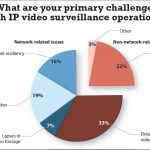June 2014 //
 The need for IP video surveillance has been rising for well over a decade. Many organizations that historically focused on securing the IT infrastructure have shifted their focus to physical security. When deployed correctly, video surveillance can be an effective tool in protecting organizations of all sizes. In fact, there have been many instances, including the Boston Marathon bombings, where IP video surveillance played a significant role in solving a crime quickly. For this reason, ZK Research predicts that the market for IP-based video surveillance cameras will grow from $4 billion in 2012 to well over $19 billion in 2017 (Exhibit 1).
The need for IP video surveillance has been rising for well over a decade. Many organizations that historically focused on securing the IT infrastructure have shifted their focus to physical security. When deployed correctly, video surveillance can be an effective tool in protecting organizations of all sizes. In fact, there have been many instances, including the Boston Marathon bombings, where IP video surveillance played a significant role in solving a crime quickly. For this reason, ZK Research predicts that the market for IP-based video surveillance cameras will grow from $4 billion in 2012 to well over $19 billion in 2017 (Exhibit 1).
Physical security often falls under the purview of the CIO, which has been a significant driver for IP video surveillance. This has led to significant evolution in the technology over the past five years. Historically, the industry was plagued with low-quality analog cameras that were built on dedicated networks and consequently were expensive to deploy and maintain.